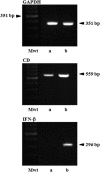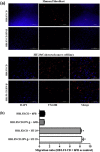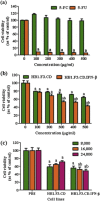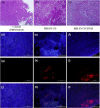Suppression of the growth of human colorectal cancer cells by therapeutic stem cells expressing cytosine deaminase and interferon-β via their tumor-tropic effect in cellular and xenograft mouse models
- PMID: 23403306
- PMCID: PMC5528496
- DOI: 10.1016/j.molonc.2013.01.004
Suppression of the growth of human colorectal cancer cells by therapeutic stem cells expressing cytosine deaminase and interferon-β via their tumor-tropic effect in cellular and xenograft mouse models
Abstract
Genetically engineered stem cells (GESTECs) exhibit a potent therapeutic efficacy via their strong tumor tropism toward cancer cells. In this study, we introduced the human parental neural stem cells, HB1.F3, with the human interferon beta (IFN-β) gene which is a typical cytokine gene that has an antitumor effect and the cytosine deaminase (CD) gene from Escherichia coli (E. coli) that could convert the non-toxic prodrug, 5-fluorocytosine (5-FC), to a toxic metabolite, 5-fluorouracil (5-FU). Two types of stem cells expressing the CD gene (HB1.F3.CD cells) and both the CD and human IFN-β genes (HB1.F3.CD.IFN-β) were generated. The present study was performed to examine the migratory and therapeutic effects of these GESTECs against the colorectal cancer cell line, HT-29. When co-cultured with colorectal cancer cells in the presence of 5-FC, HB1.F3.CD and HB1.F3.CD.IFN-β cells exhibited the cytotoxicity on HT-29 cells via the bystander effect. In particular, HB1.F3.CD.IFN-β cells showed the synergistic cytotoxic activity of 5-FU and IFN-β. We also confirmed the migration ability of HB1.F3.CD and HB1.F3.CD.IFN-β cells toward HT-29 cells by a modified migration assay in vitro, where chemoattractant factors secreted by HT-29 cells attracted the GESTECs. In a xenograft mouse model, the volume of tumor mass was decreased up to 56% in HB1.F3.CD injected mice while the tumor mass was greatly inhibited about 76% in HB1.F3.CD.IFN-β injected mice. The therapeutic treatment by these GESTECs is a novel strategy where the combination of the migration capacity of stem cells as a vector for therapeutic genes towards colorectal cancer and a synergistic antitumor effect of CD and IFN-β genes can selectively target this type of cancer.
Copyright © 2013 Federation of European Biochemical Societies. Published by Elsevier B.V. All rights reserved.
Figures






Similar articles
-
Anti-proliferative Effect of Engineered Neural Stem Cells Expressing Cytosine Deaminase and Interferon-β against Lymph Node-Derived Metastatic Colorectal Adenocarcinoma in Cellular and Xenograft Mouse Models.Cancer Res Treat. 2017 Jan;49(1):79-91. doi: 10.4143/crt.2015.503. Epub 2016 May 3. Cancer Res Treat. 2017. PMID: 27188205 Free PMC article.
-
Selective antitumor effect of neural stem cells expressing cytosine deaminase and interferon-beta against ductal breast cancer cells in cellular and xenograft models.Stem Cell Res. 2014 Jan;12(1):36-48. doi: 10.1016/j.scr.2013.09.010. Epub 2013 Oct 1. Stem Cell Res. 2014. PMID: 24141111
-
Synergistic effects of genetically engineered stem cells expressing cytosine deaminase and interferon-β via their tumor tropism to selectively target human hepatocarcinoma cells.Cancer Gene Ther. 2012 Sep;19(9):644-51. doi: 10.1038/cgt.2012.45. Epub 2012 Jul 13. Cancer Gene Ther. 2012. PMID: 22790964
-
Therapeutic potential of stem cells expressing suicide genes that selectively target human breast cancer cells: evidence that they exert tumoricidal effects via tumor tropism (review).Int J Oncol. 2012 Sep;41(3):798-804. doi: 10.3892/ijo.2012.1523. Epub 2012 Jun 20. Int J Oncol. 2012. PMID: 22736197 Free PMC article. Review.
-
Management of malignant pleural effusion by suicide gene therapy in advanced stage lung cancer: a case series and literature review.Cancer Gene Ther. 2012 Sep;19(9):593-600. doi: 10.1038/cgt.2012.36. Epub 2012 Jun 29. Cancer Gene Ther. 2012. PMID: 22744209 Review.
Cited by
-
Development and application of neural stem cells for treating various human neurological diseases in animal models.Lab Anim Res. 2013 Sep;29(3):131-7. doi: 10.5625/lar.2013.29.3.131. Epub 2013 Sep 27. Lab Anim Res. 2013. PMID: 24106507 Free PMC article. Review.
-
Synergistic effect of therapeutic stem cells expressing cytosine deaminase and interferon-beta via apoptotic pathway in the metastatic mouse model of breast cancer.Oncotarget. 2016 Feb 2;7(5):5985-99. doi: 10.18632/oncotarget.6719. Oncotarget. 2016. PMID: 26716512 Free PMC article.
-
Role of Type I and II Interferons in Colorectal Cancer and Melanoma.Front Immunol. 2017 Jul 26;8:878. doi: 10.3389/fimmu.2017.00878. eCollection 2017. Front Immunol. 2017. PMID: 28798748 Free PMC article. Review.
-
Co-treatment with therapeutic neural stem cells expressing carboxyl esterase and CPT-11 inhibit growth of primary and metastatic lung cancers in mice.Oncotarget. 2014 Dec 30;5(24):12835-48. doi: 10.18632/oncotarget.2547. Oncotarget. 2014. PMID: 25544747 Free PMC article.
-
Anti-colorectal cancer effect of interleukin-2 and interferon-β fusion gene driven by carcinoembryonic antigen promoter.Onco Targets Ther. 2016 May 30;9:3259-67. doi: 10.2147/OTT.S97444. eCollection 2016. Onco Targets Ther. 2016. PMID: 27313471 Free PMC article.
References
-
- Aboody, K.S. , Bush, R.A. , Garcia, E. , Metz, M.Z. , Najbauer, J. , Justus, K.A. , Phelps, D.A. , Remack, J.S. , Yoon, K.J. , Gillespie, S. , Kim, S.U. , Glackin, C.A. , Potter, P.M. , Danks, M.K. , 2006. Development of a tumor-selective approach to treat metastatic cancer. PLoS One 1, e23 - PMC - PubMed
-
- Aboody, K.S. , Najbauer, J. , Danks, M.K. , 2008. Stem and progenitor cell-mediated tumor selective gene therapy. Gene Ther. 15, 739–752. - PubMed
-
- Altaner, C. , 2008. Prodrug cancer gene therapy. Cancer Lett. 270, 191–201. - PubMed
-
- Bird, N.C. , Mangnall, D. , Majeed, A.W. , 2006. Biology of colorectal liver metastases: a review. J. Surg. Oncol. 94, 68–80. - PubMed
-
- Boucher, P.D. , Im, M.M. , Freytag, S.O. , Shewach, D.S. , 2006. A novel mechanism of synergistic cytotoxicity with 5-fluorocytosine and ganciclovir in double suicide gene therapy. Cancer Res. 66, 3230–3237. - PubMed
Publication types
MeSH terms
Substances
LinkOut - more resources
Full Text Sources
Other Literature Sources
Medical
Miscellaneous

